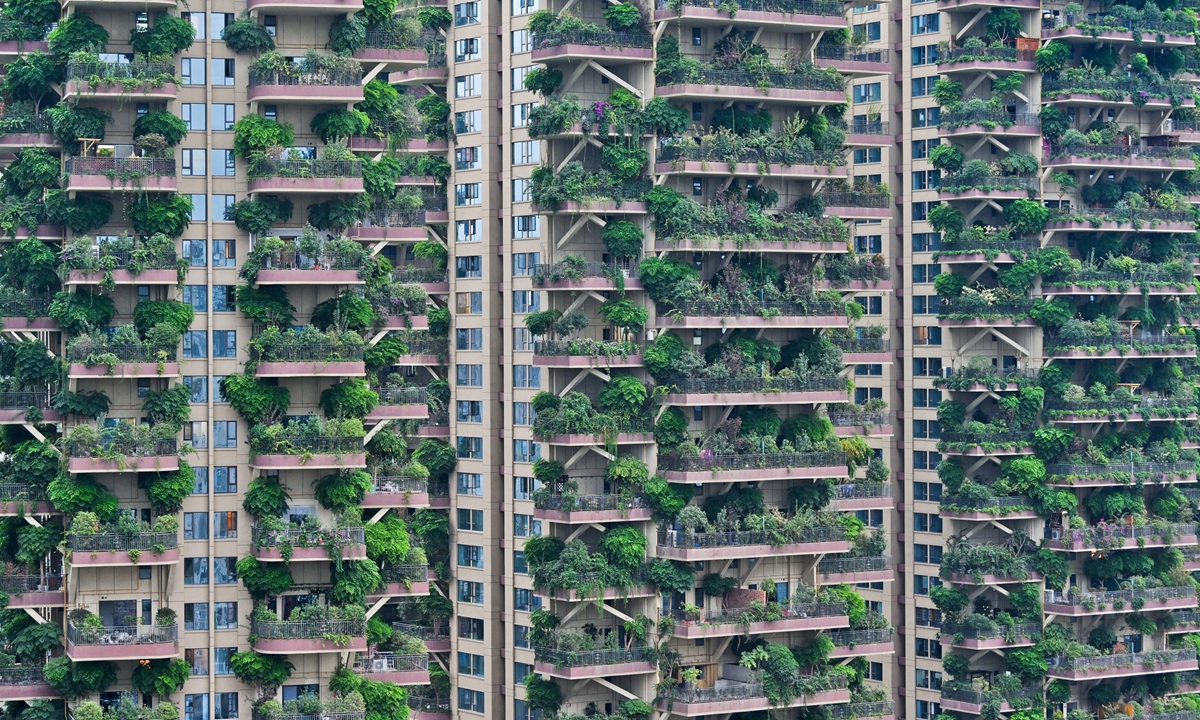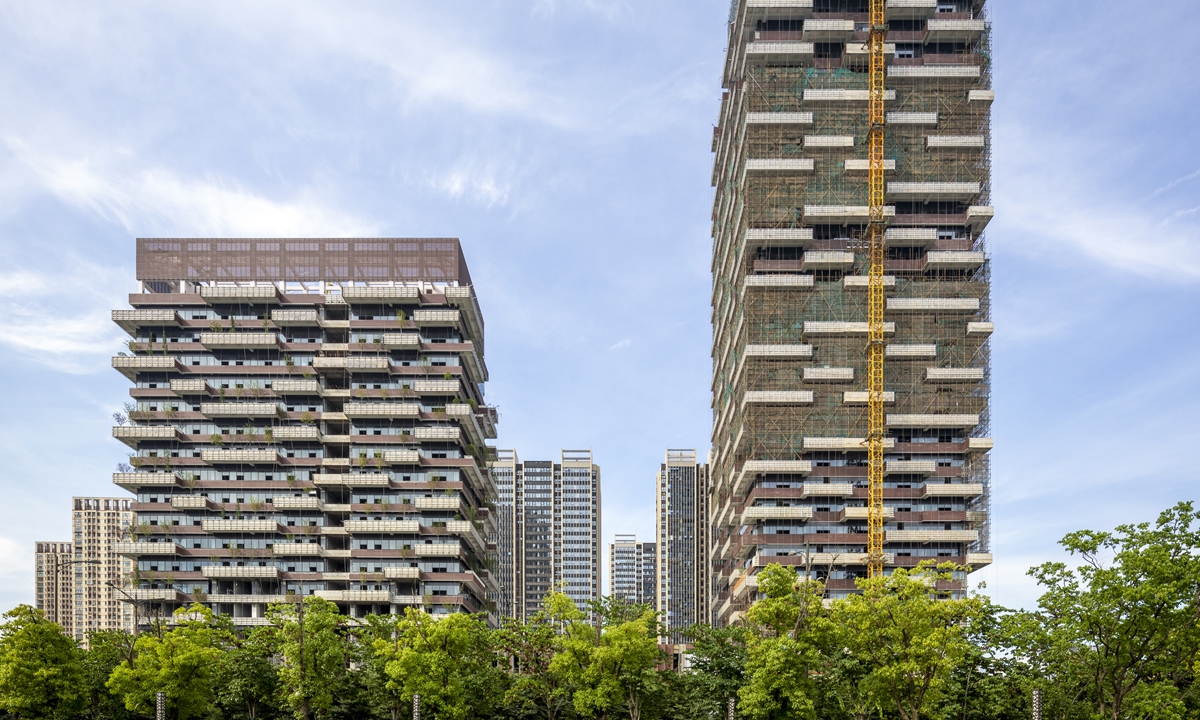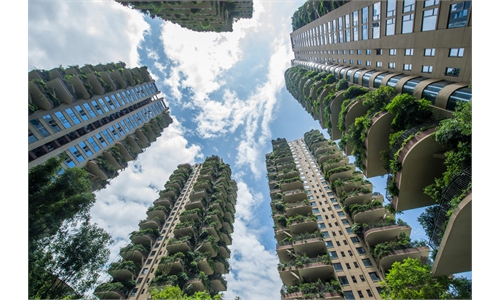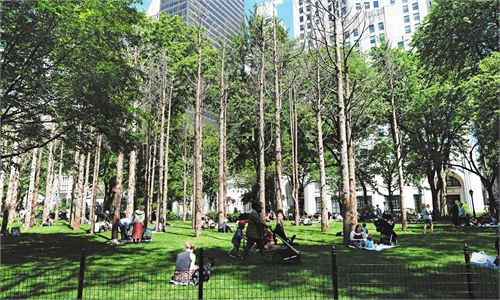China’s architects take aim at sustainable green projects to meet 2060 net zero target
Meeting the goal

Various types of plants grow on the balconies of a 30-story residential building in Chengdu, Southwest China's Sichuan Province, giving the impression of a "vertical forest." Photo: IC

"Vertical Forest" program in Huanggang, Central China's Hubei Province. Photo: Courtesy of Stefano Boeri Architetti

"Vertical Forest" program in Nanjing, East China's Jiangsu Province. Photo: Courtesy of Stefano Boeri Architetti
Chinese architects are seeking out more sustainable green urban designs in an effort to meet China's 2060 net zero emissions goal. However, business insiders recommend they should "not blindly follow successful examples abroad" while advocating for more government and individual involvement.
Just ahead of Glasgow's COP26 in November, Chinese architects are trying to find ways to reduce carbon dioxide and produce more fresh air in residential communities by designing greener buildings. To this end, they are looking to learn from the successful implementation of forest buildings overseas in countries such as Italy and Singapore.
Breathing buildings
Five years after the Vertical Forest concept was first introduced to China, a forest residential community constructed by multinational architecture company Stefano Boeri Architetti is now ready to open its doors in Huanggang, Central China's Hubei Province.
Company representatives told the Global Times that the two residential buildings in Huanggang are home to a total of 469 trees, together with shrubs and climbing plants, that are planted in special containment areas on the balconies of all apartments.
The two buildings are able to absorb 16 tons of carbon dioxide and produce nine tons of oxygen annually.
This is not the first Vertical Forest project in China. The company also constructed two green residential communities in Nanjing, East China's Jiangsu Province.
The two buildings in Nanjing also use balconies to host plants - a total of 800 ginkgo biloba, osmanthus and Chinese plum trees, 2,500 bushes and various climbing plants. In addition, they can also be seen outside the buildings.
Nanjing's Vertical Forest can also absorb 25 tons of carbon dioxide and release around 24 tons of oxygen annually to "balance the climate around the city," the team introduced.
"As carbon neutrality becomes part of common sense, the development of green buildings in the country also becomes inevitable… It helps bring back biodiversity in contemporary metropolises and improve the environment."
A bumpy road
However, these types of green buildings have been a hard sell in China, as many industry insiders and experts say that the challenges of "cost" and "practicality" are just too great.
"Due to the immaturity of the project, the cost of the plants and the technical difficulties involved in the vertical design will push China's already hard-to-afford housing prices to a higher level," one Shanghai landscape architect told the Global Times.
It is for this very reason that the present projects from Stefano Boeri Architetti have been built in second-tier cities.
"The cost issues have driven the real estate developers and the architects to do this leading experiment in a less expensive area such as Nanjing and Huanggang, instead of a metropolis like Beijing or Shanghai," said the landscape architect.
The practicality of these green buildings have also been called into question, especially when it comes to concerns that a building covered in greenery may make for the perfect breeding ground for mosquitoes and other insects.
In response, the team at Stefano Boeri Architetti said "there will be no need for such worries" as they have a three-fold solution to tackling the tricky problem that involves water quality/irrigation, drainage systems and mosquito repelling plants.
Yet insiders still worry, especially after news outlets reported that China's first eco-friendly housing project, which transformed tower blocks into "vertical forests" in Chengdu, Southwest China's Sichuan Province, has grown into a "concrete jungle plagued by mosquitoes because of a lack of residents."
According to a report from local newspaper The Times, only about 10 families have moved into Qiyi City Forest Garden, a green community with 500 apartments. Business insiders said that all of these designs are now mainly imported from Singapore and Italy, especially the former, which has "the most advanced indoor greenhouse garden technology."
Local adaptations
Still experts recommend that China should develop "similar programs that are suited to our country, as China has a vaster land area than many countries," Li Zhiqing, deputy director at the Center for Environmental Economics Studies of Fudan University in Shanghai, told the Global Times.
"This vertical development is only an innovative experiment. At present, China's huge areas mean these designs are more suitable for horizontal and low-cost buildings than expensive sky-high ones.
"Like all decision-making policies in China, these organic forestry building projects need to be changed to suitable and sustainable solutions that are able to take root in China."
Li pointed to Beijing, a city with high housing prices, noting that "this kind of high-cost construction project is currently difficult to implement, but well-maintained spread-out gardens in newly built communities in Beijing are a successful experiment."
Apart from urban construction, Li also called for China's huge population to form "low-carbon consumption habits such as abandoning plastic bags and making use of public transportation."
China's central government has made two signature commitments on climate, pledging that the country's emission of carbon dioxide will peak before 2030 and that the country will achieve carbon neutrality by 2060.
In November, the UK is set to host the COP26, an event that aims to give the world an opportunity to come together on climate change in light of recent extreme weather events.



